Documenting COVID-19: One Year On
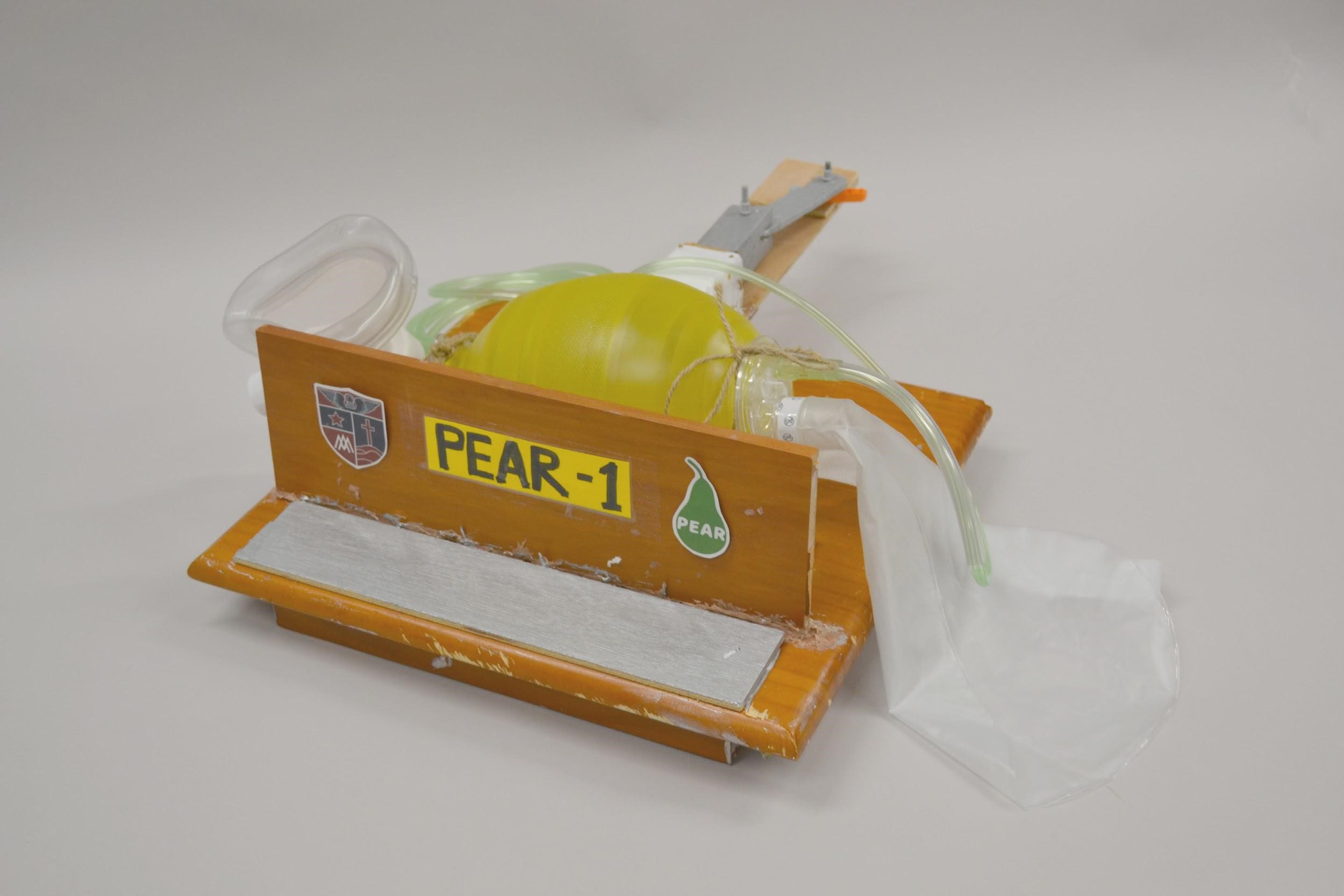
This article was originally posted on the National Library of New Zealand website.
Lockdown a collective global experience
Today is the first anniversary of the start of Aotearoa New Zealand’s Level 4 COVID-19 lockdown. At this time, one year ago today, one in five of the world’s population (around 1.7 billion people) were also experiencing some form of lockdown, including cancellations of public events and gatherings, stay-at-home recommendations and/or orders, school closures, workplace closures, and travel restrictions, just to name a few (Guardian 2020).
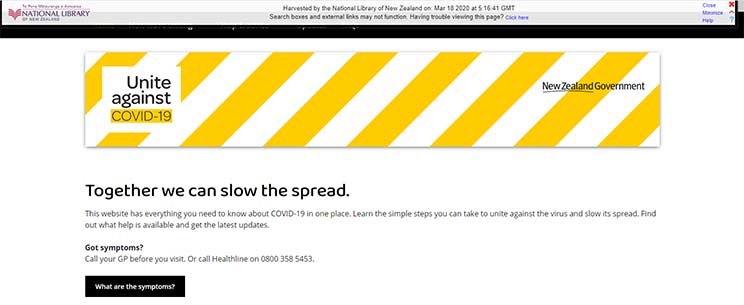
Just ten days later this number increased to nearly half of the world’s population, just under 4 billion people (Euronews 2020). Experiencing a lockdown has become a collective global experience, but our personal stories, photographs, diary entries, objects, social media posts, blogs, videos, artworks and memories that encapsulate this experience are uniquely our own.
Collecting the many different stories of the New Zealand lockdown
Across Aotearoa, libraries, museums, archives, and cultural heritage organisations, have been working to document and record the individual, family, community, and organisational stories that represent Aotearoa New Zealand’s experience of COVID-19. The generations that succeed us will read our ‘lockdown’ posts on social media, view the photographs we captured, read the blogs we posted, admire the art we created, study the things we collected, and listen to/watch the podcasts and videos we shared.
The ways that we have found to document this time tells many different stories, including the ways we found to share love, support, kindness and even laughter, while separated from each other. They also tell of the uncertainty, stress, sadness and grief, experienced through job losses, food insecurity, delayed medical treatment, and separation and isolation. Some experiences we may not be ready to share — looking back is going to be hard until we can look forward with more certainty.
However, history tells us that all pandemics end (Guardian 2020) and, as time moves forward, we will collectively build together a documentary heritage of one the most unprecedented times in our history.
A look at some of the items that have been collected
We know that our pandemic story is not yet complete, and as a country we face many unknowns. However, one thing we know for certain is that Aotearoa New Zealand’s heritage organisations are already starting to piece together, item by item, story by story, our collective experiences over the last year. As a testament to their hard work and efforts, we asked if they would share with us, on the one-year anniversary of New Zealand’s Level 4 lockdown, some of the items in their COVID-19 collections.
The items featured below reflect only a small piece of the documentary mahi that has been happening across Aotearoa, but they capture some of the ways that New Zealanders have experienced the COVID-19 pandemic, including the creativity, ingenuity, and kindness with which we have remained connected, even when being apart.
We'd like to acknowledge, with sincere thanks, the contributions to this blog from the following organisations: Tasman District Libraries, Ministry for Culture and Heritage, Auckland Libraries, Nelson Provincial Museum, Te Papa, Auckland Museum, South Canterbury Museum, Alexander Turnbull Library, MOTAT Museum of Transport and Technology, Nelson Public Libraries, Upper Hutt City Library and Palmerston North City Library.
Tasman District Libraries — 2020 Lockdown Quilt
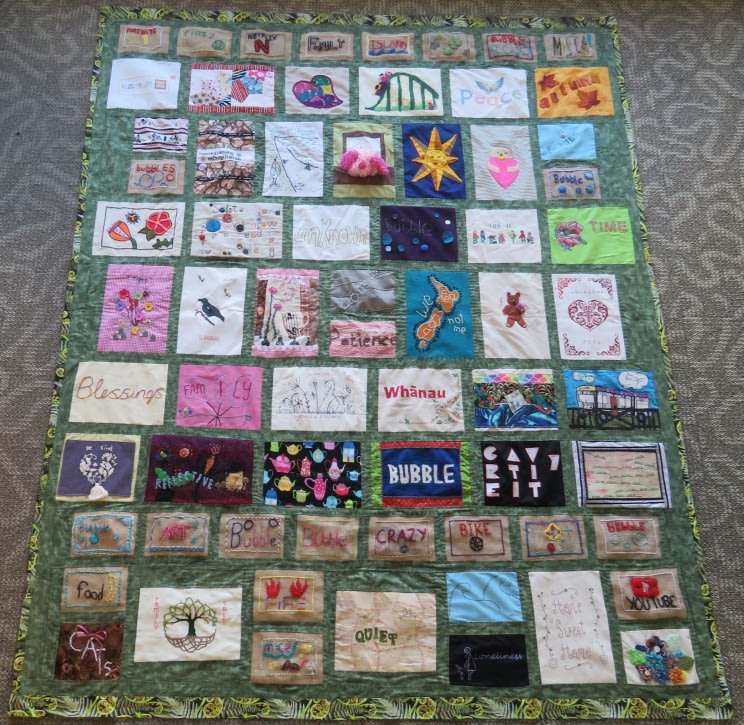
In May 2020, Tasman District Libraries invited people of all ages from across Te Tau Ihu, The Top of The South, to stitch a word or image relating to their experience of Covid-19 Level 4 Lockdown to a piece of fabric. These embroidered panels were then pieced together by textile artist Christine McGuigan into a quilt. The quilt forms a patchwork of our communal experience of an extraordinary time.
The quilt involved creating something separately, together, in the same way that lockdown was a communal effort that was completed separately, but together, for a common purpose.
Upon completion, the quilt was exhibited at various venues across Te Tau Ihu, The Top of The South beginning with the Gallery Wall at Richmond Library for the one- year anniversary of Level 4 lockdown.
Manatū Taonga Ministry for Culture and Heritage — Kei roto i te miru: inside the bubble podcast
'Kei roto i te miru: inside the bubble' is a podcast series capturing New Zealander’s experiences during the 2020 nationwide lockdown. In this audio clip from the first episode ‘We Prepared’ Angelique describes how she prepared for the lockdown.
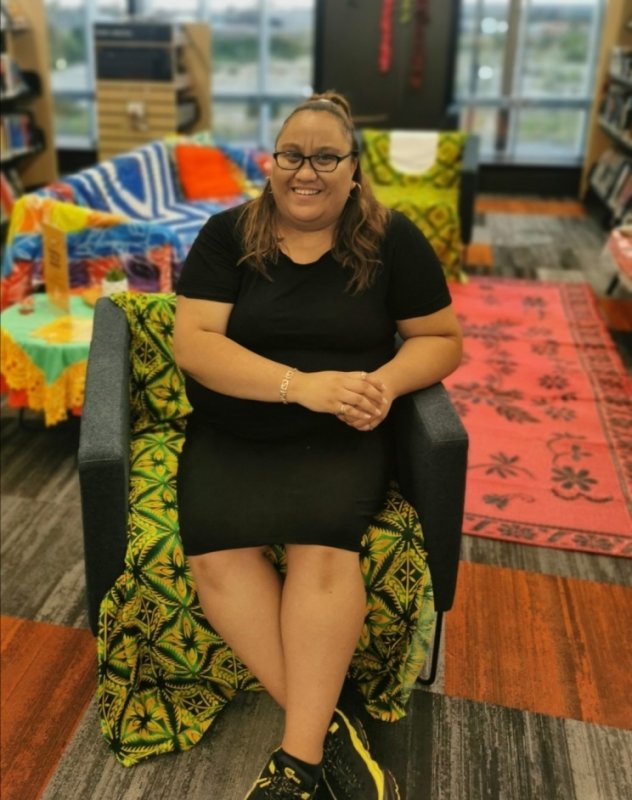
Kei roto i te miru: inside the bubble (excerpt)
TRANSCRIPT:
Speakers
Angelique Tuaputa, Dr Emma Jean Kelly
Dr Emma Jean Kelly: Angelique, who works as a Pasifika specialist Librarian in Auckland, was initially in denial about going into lockdown.
Angelique Tuaputa: I was away with the fairies. Because, I didn’t know what I was going to do during that time. But my sister was very focussed, out of the both of us. And I remember I was getting paid, I think, the Wednesday before lockdown. I was getting paid that day and all I could think about and all I could really focus on was, I need to go shop, I need to go and buy things for the house. And that happened to be our shopping week. I get paid fortnightly so, I always look forward to pay week and payday, like everyone else does.
My sister had a plan, she had written this plan down, and she had this plan with me. I think both of our minds were — she was expecting lockdown, I wasn’t. I was like nope, this is just going to be temporary, I’m going to go back to work. After two weeks it’s gonna be all fine.
Dr Emma Jean Kelly: Meanwhile, Angelique's younger sister Florence went into full prepper mode.
Angelique Tuaputa: She already had it in her mind that, no, we need to start preparing. She became the panic shopper. And I became the wingman to the panic shopper. So when the news came out — those last 48 hours were a big blur and a big rush – but I remember going to four different places to buy all our essential items. We went to two supermarkets, one veggie shop, the Warehouse.
And we got everything, from blankets to comfy clothes to wear during lockdown, like pyjamas. And I remember when we went shopping we took our dad with us. And we had this plan that this person would grab this stuff, and I felt like I was in Armageddon. Because I felt like we were just gonna grab all of this stuff, and then just like stock it in our homes.
TRANSCRIPT ENDS
The history team led by Dr Emma Jean Kelly, Audio-Visual Historian recognised the importance of recording the experiences of New Zealander’s as we went into our bubbles for the lockdown. With support from Auckland Libraries, we enlisted the help of nine oral historians from around Aotearoa to collect oral history interviews with people from a diverse range of communities and life experiences including; Healthcare workers, Māori whānau, people with disabilities, Pasifika, Pākehā, older people, people from the LGBQTI community, teens and international backpackers.
'Kei roto i te miru: inside the bubble' uses these oral histories to reflect on how we responded collectively as a nation to this moment in history and shares some of the many ways New Zealander’s experienced the lockdown.
The podcast will be available on the Radio New Zealand podcast channel, Spotify and Apple from 25th March 2021 with episodes released weekly for five weeks. You can also hear the series broadcast on ‘Nights with Bryan Crump’ starting Monday 29th March from 7pm.
Auckland Libraries — Mandala Art
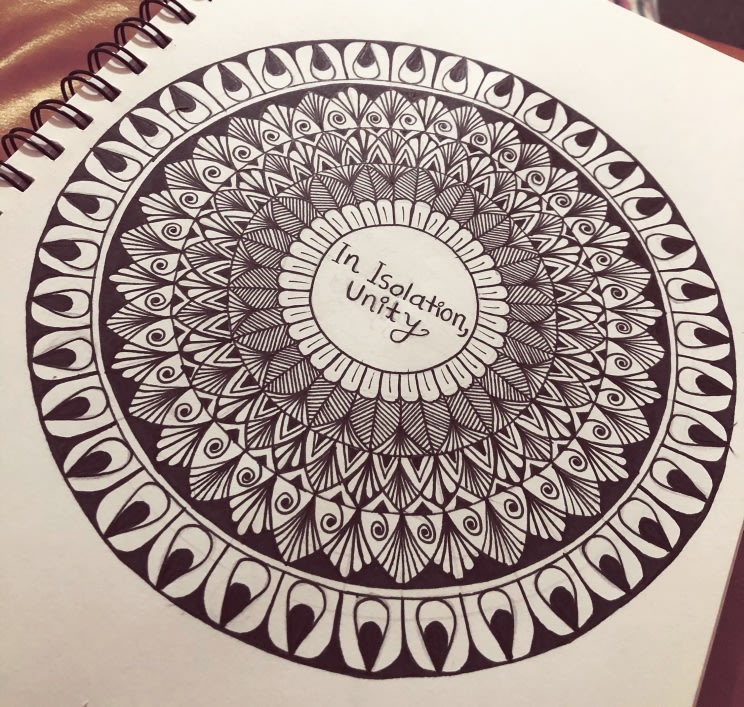
During the first COVID-19 Lockdown Kunal Labhubhai Parekh began creating intricate mandala artworks as a way to counter the increasingly overbearing media coverage of the coronavirus epidemic. He practised drawing mandala as a form of meditation and produced around one ink drawing per day. He would often gift these artworks to his friends. Kunal kindly donated ten of his drawings to Auckland Libraries from his art diary. Kunal Parekh grew up in Ahmedabad, Gujarat, India, and moved to Aotearoa New Zealand in 2013.
Nelson Provincial Museum — ‘Keep Your Distance‘ Uniform T-Shirt
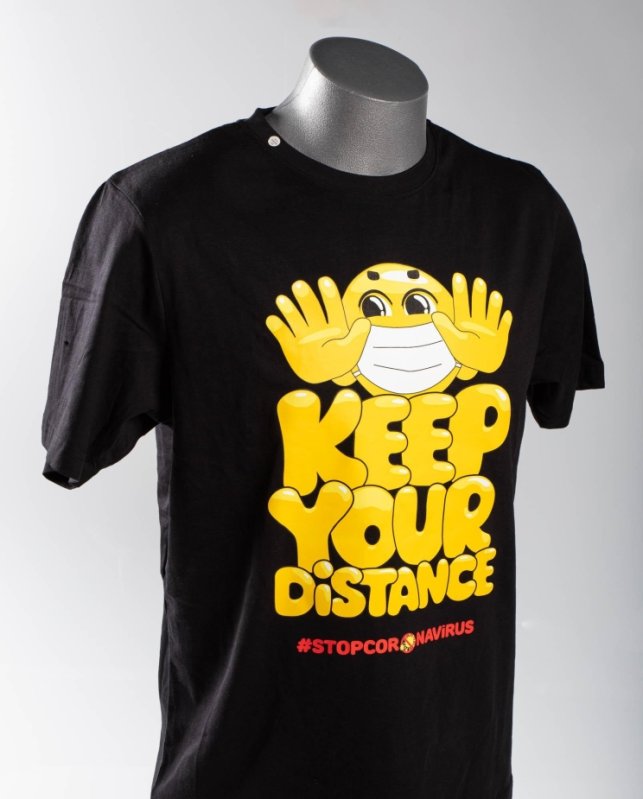
This t-shirt was worn by staff at Nelson’s FreshChoice grocery store from April to June 2020 as a firm yet fun reminder to shoppers to maintain social distancing. Initially developed as a laminated sign and hung around the neck, the in-house design was then transferred to a t-shirt. This object is a reminder of the risks that essential workers faced whilst performing their jobs at the height of the COVID-19 pandemic in New Zealand.
The Nelson Provincial Museum in partnership with the Nelson Public Libraries and Tasman District Libraries created the platform “Life in the Bubble” to collect and preserve stories and experiences of the COVID-19 pandemic. This platform is still open for submissions.
The museum is still collecting photographs, objects and ephemera relating to COVID-19, see our current listings.
Donation enquiries can be sent to enquiries@museumnp.org.nz
Te Papa — Poly scrubs
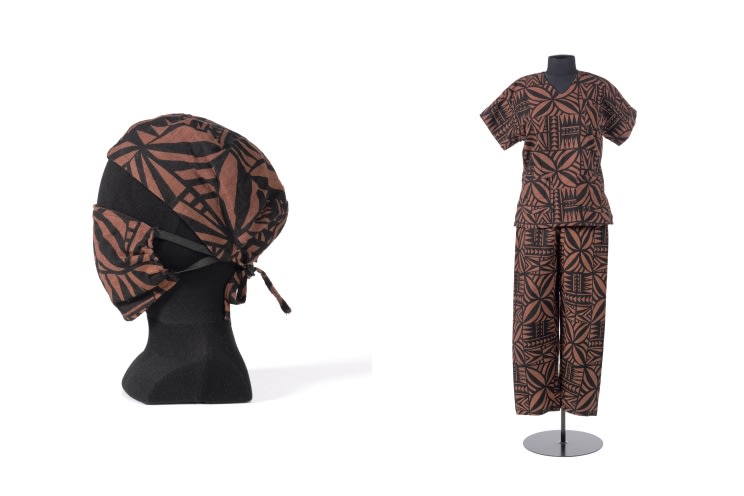
These Poly scrubs were worn by Dr Shavonne Duffy, a General Practitioner based in Tāmaki Auckland. Staff were encouraged to wear medical scrubs as a means of protecting themselves and their wider whānau from contracting COVID 19. Shavonne did not have her own and her workplace had run out of supply. Her mother, Lolita Asopesio Duffy made these scrubs with leftover material from the puletasi (Sāmoan two-piece formal dress) she had made for her daughter’s graduation a couple of years earlier.
Recounting her experiences of lockdown last year, Shavonne shares:
Initially, I was terrified for my patients, my colleagues and for my family. We could see what was happening in northern Italy. My concern at the time was that New Zealand would be put in the same situation. If COVID infiltrated the community, it would be catastrophic.
We were advised by the Royal New Zealand College of General Practitioners that we should aim to have 70% of our consults via phone/virtual consults. We had to change the way we delivered healthcare. We transitioned from having a busy waiting room and seeing patients face to face, to phone triaging, phone consultations and screening every person who walked through the doors.
Some of the fears and challenges of this period included patients being frightened to go to hospital and exposing themselves to COVID, seeing the financial impact first-hand, whilst trying to provide safe health care and minimising risk to our staff and patients.
These scrubs help us tell the stories of essential workers, the changes and difficulties for those working and using health services, and the uptake in the use of Personal Protective Equipment (PPE).
Auckland Museum — Fence Puppets knitted by Bo Hensley
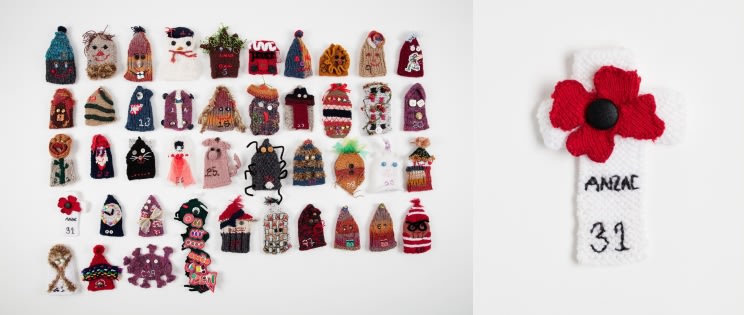
Bo Hensley decided to mark the passing of time over lockdown by knitting one puppet each day and placing it on the picket fence outside her house in suburban Auckland. What started as a personal project quickly became a collective one, as children and neighbours began visiting each day to see the latest puppet and provide suggestions (and materials) for the next ones. The 43 numbered puppets incorporate the creative ideas and gifts of local children, as well as plants and buildings in the neighbourhood. The puppets also documented significant moments during lockdown for New Zealanders, with one featuring a cross for the day that the first person in the country died of C-19 and one with a poppy to mark Anzac Day.
The puppets were one of almost 100 collections acquired by Auckland War Memorial Museum as part of its Covid-19 Collecting project, which focused on the experience of the first 2020 lockdown for Aucklanders and the surrounding regions. Before embarking on such a large-scale contemporary collecting project across different disciplines and formats, we developed a strategic framework for the project and decided that a community collecting approach was the best way to ensure that we captured as many diverse voices and perspectives as possible. The Museum put out a public call for material in April 2020, and received a huge number of offers from across Auckland, including lockdown diaries to photographs of empty streets and bread shelves, messages of solidarity written on banners to teddy bears placed in windows; examples of home-schooling and lockdown crafting to combat boredom and anxiety; items that reflected the experiences of essential workers and the creative ways the community marked important occasions like Anzac Day and Easter. Alongside this collection, Auckland Museum is also undertaking targeted collecting to capture the experiences of those not captured in the crowd-sourced collecting project, particularly Māori perspectives, and to reflect the ongoing changing nature of the pandemic.
Auckland Libraries — KIA ORA mask
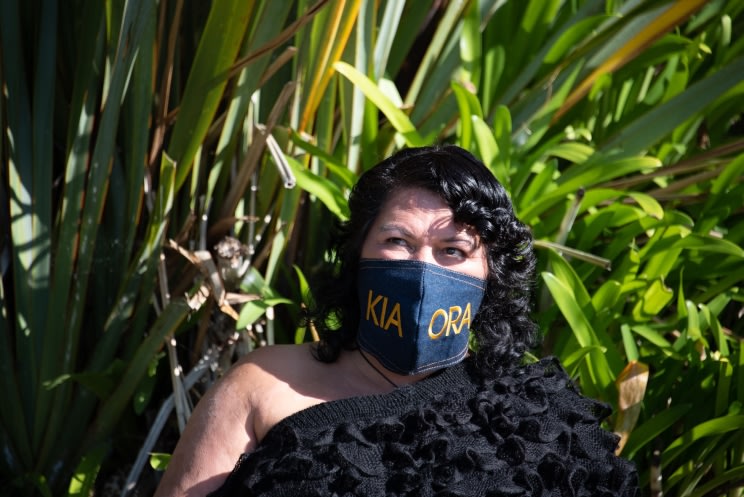
International fashion designer and activist, Jeanine Clarkin, wears the KIA ORA mask she created during the first Lockdown in 2020. Handshakes and hongi were banned during Lockdown, and this was a way for Jeanine to express her identity, by getting her ‘KIA ORA’ out to people.
Donation enquiries to 'A snapshot in time: COVID-19 archive' can be sent to: sharon.smith@aucklandcouncil.govt.nz
South Canterbury Museum — Ranui Kindergarten Book
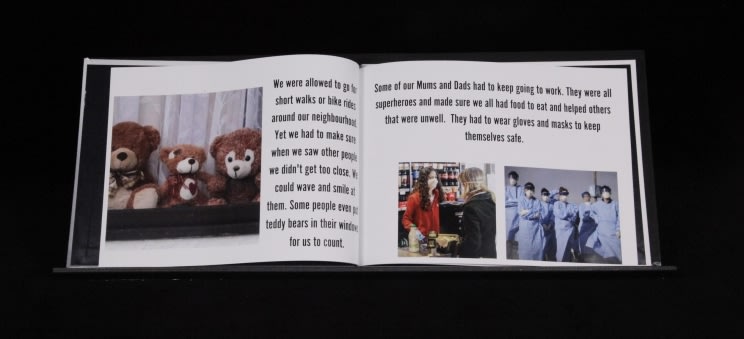
This children’s book was written by Donna Rooney and kaiako/teachers at Timaru’s Ranui Kindergarten. It tells the ‘story of how we all became superheroes to fight COVID-19 by staying at home’. It explains the virus and the experience of the lockdown. It talks to the young audience about the now very familiar pandemic concepts of physical distancing, safety precautions, and essential workers. Importantly, it also addresses the sadness of not being able to visit friends and family during the lockdown. At the end of the book there are photographs of Ranui tamariki/children and the activities they got up to during the lockdown.
The goals of the book were to support tamariki in the transition back to kindergarten and to provide a resource to revisit the lockdown experience. It has been a terrific hit with the tamariki who enjoy seeing themselves and their experiences in print, and there has been a very positive response from families.
The book’s title is ‘When we all became superhero’, which obviously contains a grammatical error, but this also speaks to the pandemic experience of having to make it up as we went along – how to work from home, help our neighbours or try to explain this scary event to our kids. The book title isn’t perfect but the message is, and it connects with the people it is for.
The book was added to the Museum collection because it is a great example of a local response to the pandemic and it highlights the experiences of our community’s youngest members whose stories can be easily overlooked.
Te Papa — Muka face mask
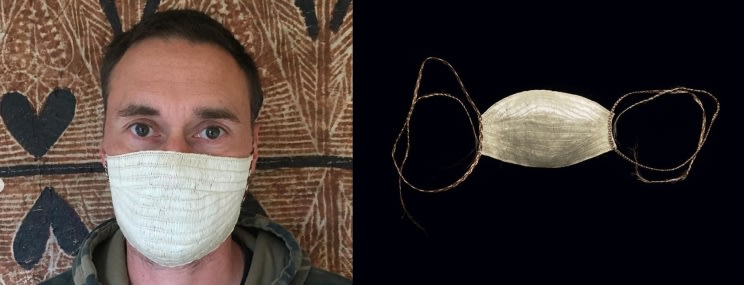
This is a Muka Face Mask made during the Level 4 Covid-19 rāhui by artist Matthew McIntyre-Wilson (Ngā Mahanga, Titahi, Taranaki). At the start of March, Matthew was in Sydney with a delegation of Māori students and staff from Massey University attending events related to the recently-opened Biennale. As the impact of the pandemic became more immediate in Aotearoa, the trip was cut short and the delegation returned to Aotearoa to begin a period of self-isolation together. It was at this point that Matthew conceived at began to create the Muka Face Mask. During this period of self-isolation, it was announced that the country was entering into Alert Level 3 for 48 hours before entering Alert Level 4 for four weeks. This was an unprecedented change but illustrates how swiftly the pandemic-related government directs were enacted and these changes are also part of the story that contextualises the making of the Muka Face Mask.
The Muka Face Mask is made from almost entirely from aho poka of muka, short wefts that, when woven in a particular way, can mirror the concertina folds of a surgical mask. Matthew mentioned that he first got the idea for using this technique after seeing a surgical mask and believing that he could the aho poka (where there is no introduction or reduction of whenu) can be used to round the face in the same way as a surgical mask.
This technique also illustrates a metaphorical link to the kaitaka and pāke and their ability to be used as protection. This is in reference to Ruhia Porutu’s well-known protection of Thomas McKenzie by throwing her kaitaka on him. It also references the impenetrability of pāke after they are submerged in water and their fibres then swelling to fill any gaps. After making the mask, Matthew shared two images of his mask response on his Instagram account. The first was of the work in progress accompanied by an explanation of the weaving technique he was using and where he learned of the technique: “I have an interest in fine muka kākahu created in the 18th century and collected on Captain James Cook’s voyages to New Zealand. There is more to be learnt about the technologies used by Māori makers through making. To be able to study and repatriate the techniques used in these kākahu would be valuable to other makers, weavers and academics in helping to understand more about the complexities of these objects.”
A further element of this mask are the taura that will be used to secure the mask. These are woven in a 9-ply braid, some strands of which have been dyed with tanekaha using a cold-brewed technique. The braiding technique itself features two different patterns, which is a reference to kākahu in overseas institutions (including a kaitaka paepaeroa in Edinburgh) where the kaitaka is bordered with braiding rather than tāniko.
National Library of New Zealand Te Puna Mātauranga o Aotearoa — Prepare to be kind
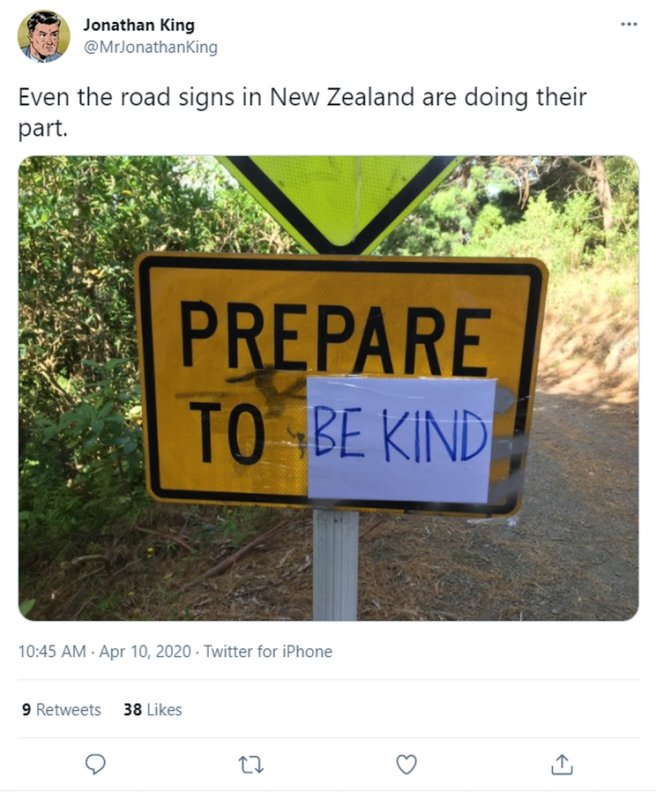
When #Covid19nz began trending on Twitter, Web Archivists at Te Puna Mātauranga o Aotearoa the National Library of New Zealand started collecting relevant hashtags and keywords via the Twitter API to ensure that the Aotearoa New Zealand-focused COVID-19 Twitter conversation was captured. They did this as part of the Library’s legislative mandate to collect, preserve, and protect documentary heritage and taonga relating to Aotearoa New Zealand.
One Tweet shared during the Covid-19 Level 4 lockdown was by New Zealand film-maker, and comic creator, Jonathan King. His Tweet documents one of the many creative ways New Zealanders found to share the message of kindness in response to the pandemic.
The photograph, captured 15 days into New Zealand’s Level 4 lockdown, shows a bike hazard sign along the walking/bike tracks of Mt Victoria, in Wellington. Originally intended to warn bikers to “PREPARE TO STOP” the sign was creatively repurposed, with sticky tape and paper, to share a different message, now reminding New Zealanders to “PREPARE TO BE KIND”.
The person who redesigned the sign has not been identified, but Jonathan’s commentary on Twitter that “Even the road signs in New Zealand are doing their part” captures the sense of common purpose felt across New Zealand during this time. His Tweet is also an example of how social media provided a forum for interactions that supported a sense of community, even when we were physically separated from one another.
Te Papa — Cat Xuechen Xiao, ‘I am from Wuhan T-shirt’
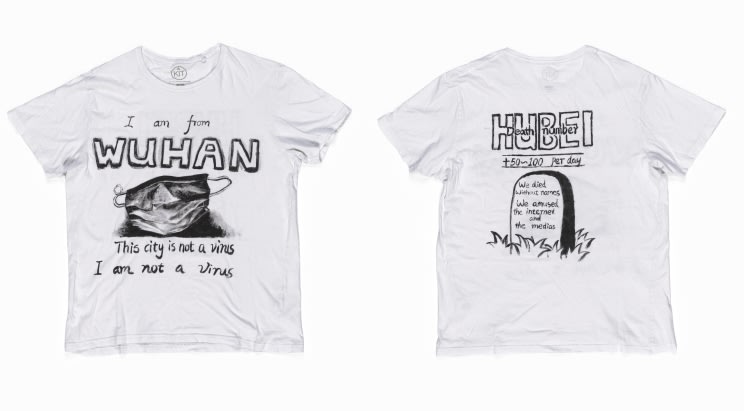
This T-shirt was created by Chinese New Zealand artist Cat Xiao in February 2020. She made the shirt at her home in Christchurch and subsequently shared it on her Instagram feed under the internationally-recognised #iamnotavirus hashtag. At the time, the majority of reported deaths from Covid-19 were from mainland China.
As a Chinese New Zealander originally from Wuhan, Cat maintains strong connections with friends and family in China and was in regular contact with them from the very earliest months of the pandemic. She says she made the shirt in response to a lack of empathy for victims evident in much online coverage and on social media.
One of my friends lost her mother and couldn’t get to see her for a proper goodbye, couldn’t even have her relics, everything was burnt in an incinerator. But at that stage when the world was not alerted, their tragedies were just another story for the internet residents to consume. I made this T-shirt to tell others that behind the masks there are lives being lost, families being torn apart and cities losing their backbones.
Cat’s shirt is revealing of the ways in which, in an increasingly globalised world, many New Zealanders’ experiences of the pandemic have been deeply entangled with those of loved ones overseas. It also reminds us of the ways in which digital technologies have undermined notions of strict geographical boundaries.
This shirt was collected as part of Te Papa’s 'Making Sense of Pandemic' project, aimed at capturing the ways in which ethnic Chinese living in Aotearoa have mediated their pandemic experiences on- and offline. Te Papa’s Making Histories programme, launched last month, also explores different experiences of the Covid-19 pandemic through a mix curatorial, digital and public activities.
MOTAT Museum of Transport and Technology — Mechanical Breathing
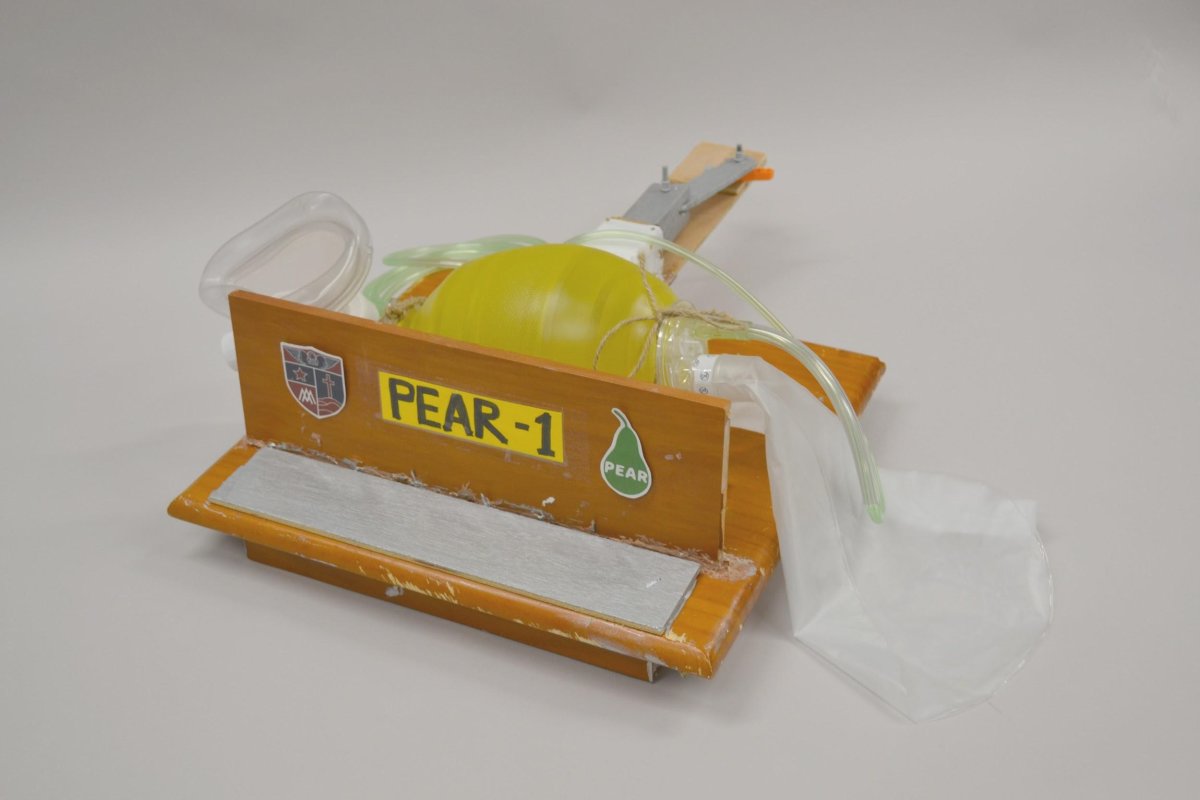
Developed by seven students from St John’s College, Hastings, the PEAR-1 ventilator is a prototype for a low-cost ventilator. The PEAR-1 ventilator prototype was created during New Zealand's Level 4 lockdown in direct response to the Covid-19 pandemic and the resulting global shortages of life sustaining equipment, including ventilators. As a group project, the Level 4 lockdown necessitated the use of various means of communication, in particular Zoom, to develop the prototype.
The leader of Project Pear, Dylan Wijaya says:
Due to the Level 4 lockdown, we could not easily get the parts required so we improvised and heavily relied on community donations such as the Ambu bag from the Hawkes Bay District Health Board …. We planned to refine the model and create a few more prototypes after the lockdown and then open source the completed product for anyone to improve and implement. We believed that it would be most effective in alleviating the crisis by providing our design to organisations worldwide that are much more capable than us in producing these ventilators at a large scale.
The PEAR-1 ventilator is an example of New Zealand innovation that showcases the use of easily sourced materials to develop an affordable solution to a problem. Project Pear’s use of contemporary communication technology, specifically Zoom, talks to the significant upsurge of such communication technologies and the connectivity and innovation they allowed during New Zealand's Level 4 lockdown.
View a short video of the ventilator in action (Google drive)
Auckland Libraries — Ginny Haynes, Managed Isolation, Mask Party
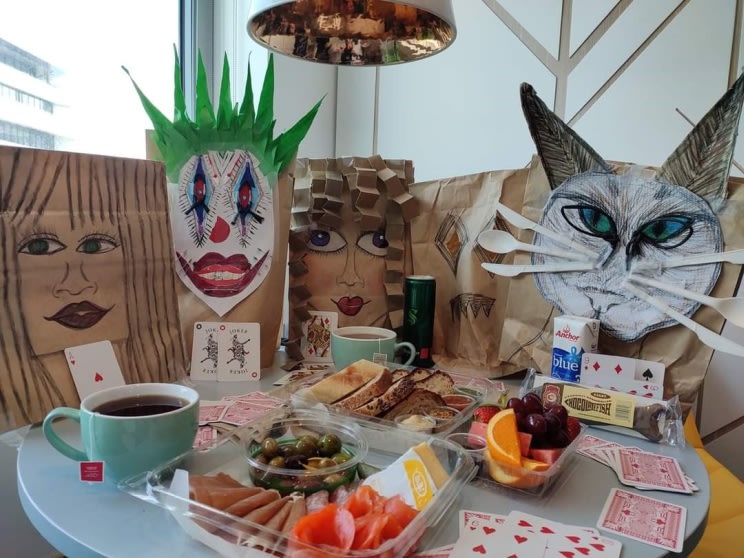
Ginny Haynes is a New Zealander currently living in Australia, she returned to New Zealand in late 2020 to visit a family member who was unwell at the time. She stayed at the managed isolation hotel M Social, in central Auckland, before she could enter the country.
To keep herself busy during her stay she made masks from the paper bags that her hotel food arrived in, and posted photographs of them online. Each mask has a message written on it relating to some aspect of her stay in managed isolation.
The paper bag masks feature in the ‘Leaving Party’, which they held in her honour, when she was due to leave the hotel after a quarantine period of two weeks. Photographs of these masks became popular posts on the NZ Hotel Quarantine Facebook site. Ginny also made a short film clip of the party to mark the celebration of her departure from managed isolation.
Donation enquiries to 'A snapshot in time: COVID-19 archive' can be sent to: sharon.smith@aucklandcouncil.govt.nz
Nelson Public Libraries – Visual Diary: Too Much Zoom
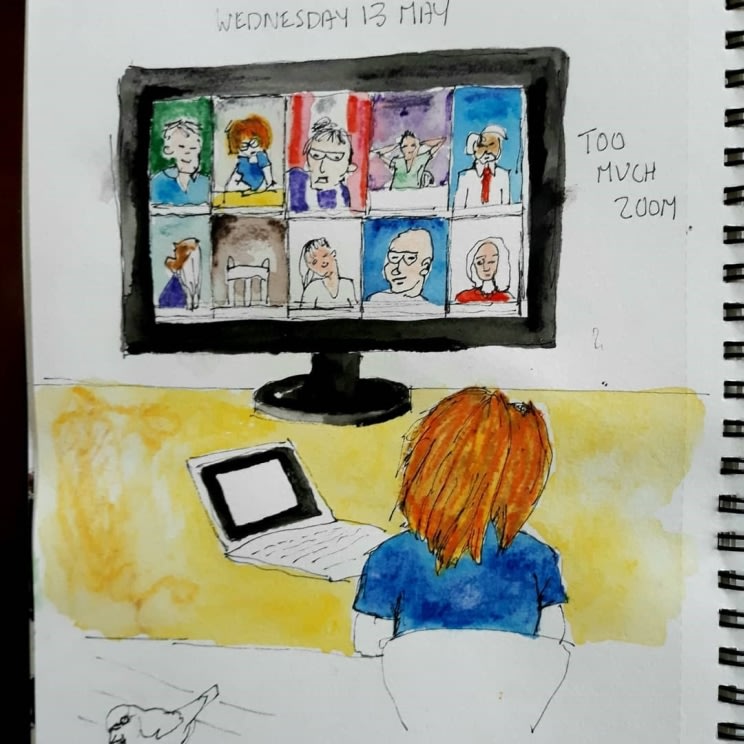
Karen Lee works for Nelson City Council and was one of the many who re-adjusted to working from home. Throughout the lockdown period she kept a visual diary which documented how we continued to go about our ‘normal’ routines in a slightly different way.
Her watercolours captured the sense of unease we began to feel when going grocery shopping and getting close to others, celebrating events such as Mother’s Day from our homes and the fatigue that began to set in for those sitting down to work each day.
'Too Much Zoom' shows how we were able to keep working and connecting with others thanks to the technology, but also how quickly we began to grow weary with it. While this may look like a regular workplace, the laptop and bird are a simple reminder that our homes had become our new offices.
Upper Hutt City Library — Rock Your Bubble lockdown street art
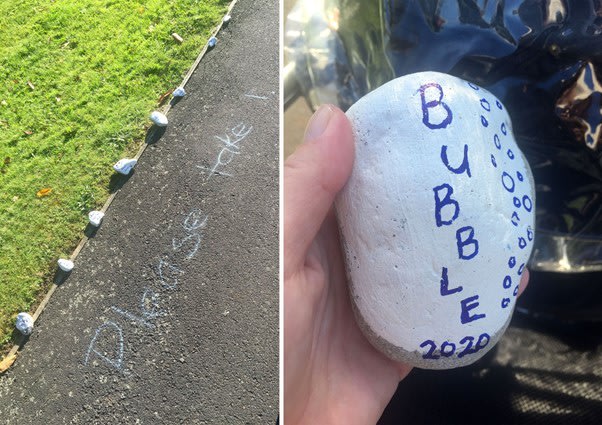
Motivated by an awareness that it was important for us to document our own local community’s experience of the pandemic as it was happening, Upper Hutt Libraries began collecting Covid-19 related content for our archives a couple of weeks before lockdown began. At first we mainly collected photographs but by mid-April we also started using tools like Zoom to record local people, in a range of different situations, talking about life under lockdown while they were still in it. While these interviews have a certain rough and ready quality to them we felt they were valuable in capturing the immediacy of the experience without benefit of hindsight. All this content was then made publicly available on our Recollect archival website.
The item we’ve chosen to highlight for this blog reflects the interest we had in recording, not just the disruption to our community caused by the pandemic, but also the re-assertion of community that occurred as people looked for ways to remain connected despite the restrictions. While maybe not entirely compliant with hygiene rules (our photographer did sanitise the rock before collecting it) it’s one of many examples we came across of street art being used to entertain and communicate with others within socially constricted circumstances. It’s also a reminder that there was a time, very early on in lockdown, when the notion of having a ‘bubble’ still remained amusingly novel to people.
Auckland Libraries — Project Lockdown

Jiehua Ma’s art journal is full of beautiful hand drawn scenes and hand written descriptions documenting daily life during Alert Levels 4 and 3 of the first lockdown during the COVID-19 pandemic in Aotearoa New Zealand. As well as being a talented artist, Jiehua Ma works as a Senior Library Assistant for Auckland Libraries. In May 2020 photographs of her art journal were posted to the Remuera Library Facebook page where it was seen by Auckland Libraries Heritage collections staff, Jiehua Ma was approached by the Heritage Collections team, and kindly agreed to donate a digitised version of her art journal to the ‘A snapshot in time: COVID-19 archive’
Donation enquiries to 'A snapshot in time: COVID-19 archive' can be sent to sharon.smith@aucklandcouncil.govt.nz
Palmerston North City Library — Shield’s Up
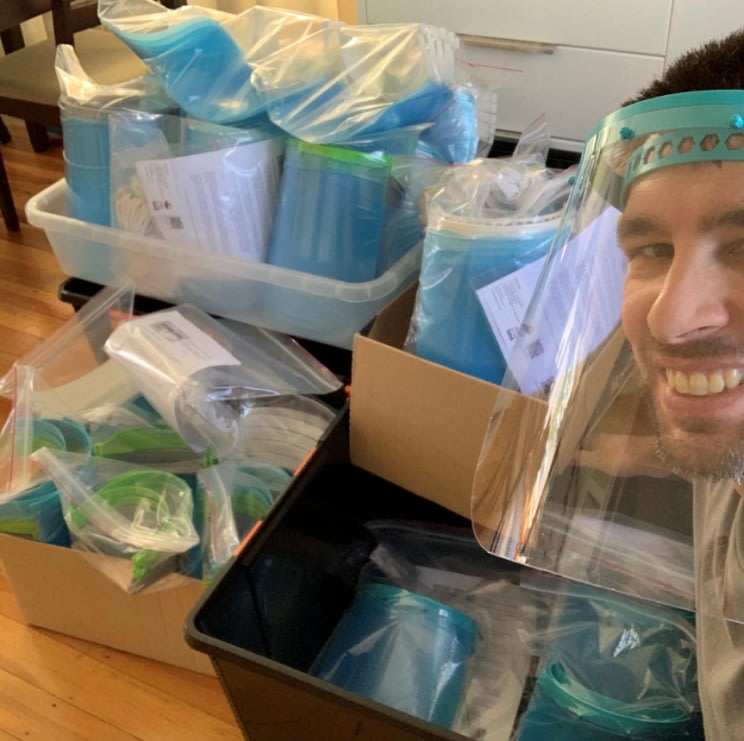
During the first lockdown, our library Makerspace – Blueprint – volunteered its 3D printers and staff expertise to the ‘Shield’s Up’ initiative. Coordinating local makers with 3D printers and engaging Te Manawa Museum machines, staff rotated on morning and afternoon solo shifts to produce over 800 shields in March and April 2020. The flexible design was iterated several times over the course of lockdown but could be printed eight at a time over eight hours. The shields were distributed safely to local healthcare providers until commercially available PPE became more easily accessible. There are around 50 remaining examples of the shields at Blueprint.
The Ian Matheson City Archives collected many born digital images during lockdown through the community contribution feature of its online repository Manawatū Heritage, including images, videos and oral histories in the Covid-19 Pandemic collection. View the collection here.
Alexander Turnbull Library — Queerantine Bingo
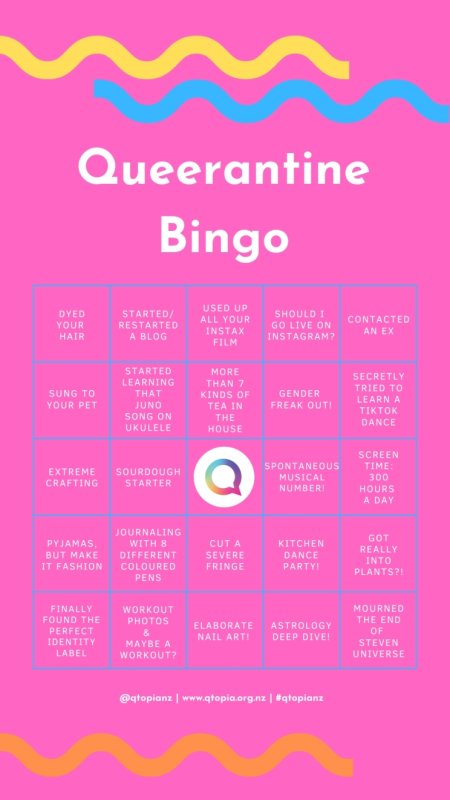
With in-person communication limited during the nationwide Level 4 Lockdown, there was an explosion of online content relating to Covid-19. Organisations and individuals shared information and experiences via websites, email newsletters, blogs, and of course social media.
The Alexander Turnbull Library’s digital collecting team has been collecting websites since 1999, and harvesting Twitter hashtags relating to significant events in Aotearoa New Zealand for the past five years. Unsurprisingly, over the past year, there has been a surge of digital ephemera, including memes, posted to social media relating to COVID-19.
One such example is the ‘Queerantine’ bingo card, posted by Qtopia to their Facebook and Instagram pages a few weeks into the Level 4 lockdown. Qtopia is an organisation which supports rainbow young people in Ōtautahi Christchurch and the wider Waitaha Canterbury area. During the lockdown, queer and trans youth had fewer opportunities to engage with others in their community, and didn’t always have support or understanding within their bubbles.
The bingo card lists various actions and feelings that LGBTQIA+ youth in particular may have experienced in lockdown, inviting them to reflect on their lockdown experience, and feel greater connection through understanding that they’re not alone in these experiences.
Thanks
Thanks to everyone who contributed to this blog. We've enjoyed working with you and sharing your collection items.